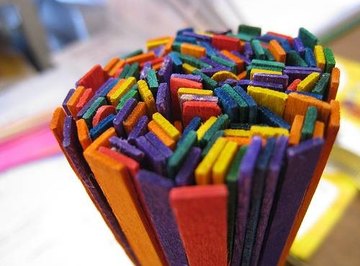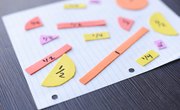
Math manipulatives provide a concrete resource to help students understand intangible math concepts. They assist you in keeping student attention and make math more fun for students. Teacher store shelves abound with brightly colored manipulatives. Unfortunately, they also often come with a hefty price tag. Manipulatives though, need not be store-bought to be effective. Many common, inexpensive household and craft objects make fine substitutes for the more expensive commercial variety. Involve your students in creating them and their interest in them will increase too.
- Computer
- Internet connection if desired
- Buttons
- Beans
- Legos
- Small erasers
- Pebbles
- Beads
- Shells
- Permanent markers
- Containers to hold objects
- Egg cartons
- Mini muffin tin
- Index cards
- Colored paper plates
- Construction paper
- Glue
- Scissors
- Craft sticks
- Cardboard
- Sentence strips
- Fun Foam
Teachers can use fun foam with the die-cut machines usually found on campuses. Cut the fun foam into tangram shapes, fraction pieces, small objects to count or geometric shapes to use in math practice.
Utilize technology to create math manipulatives online or from a website offering printables. Children love using technology so take advantage of this. Many websites offer free color or black and white printables. Color as needed then attach them to poster board. Laminate them if desired. You can also create your own manipulatives using desktop publishing software. Use the shape tool to create pattern blocks or tangrams. Locate clipart of dominoes or playing cards to print and use in math games. Create your own math war game by making playing cards that contain math equations for your kids to solve as they play a math version of the child's card game War.
Create counters for use with number sense, equations, patterns and sorting. Buttons, beans, small Legos, colored erasers, pebbles, beads or shells make excellent counters. Have students mark buttons, beads or pebbles on one side with marker or paint to use with fact family and equation practice. Students can use Legos to create base ten stacks or patterns. Instruct students to write numbers on the shells, pebbles or buttons then use them to practice equations. All of the items can be used by students to perform estimation by filling two identical containers with two different objects such as pebbles in one and beans in another. Students then estimate how many are in each before counting them to verify their answer.
Have students create multiplication practice kits with egg cartons or mini muffin tins and a counting object. Write equations on index cards. Use by flipping a card to see the equation. The first number in the problem represents the number of groups and the second represents the number of objects in each group. Students count the number of egg slots or muffin cups to match the first number and use the second number in the equation as the number of counting objects, such as buttons, to put in each egg slot or muffin cup.
Use paper plates to create fraction practice pieces. Use colored paper plates to make pizzas or pies. Each student makes one whole pizza or pie by decorating the plate appropriately. They then use more plates to create different fraction sets such as halves, thirds, fourths and eighths. Use them in a game by having them create cards with different fractions on each card. Place the cards upside down after shuffling. Each player has his set of pizza or pie fraction pieces. Students turn over a card and must place the corresponding fraction on top of their whole pizza. The winner is the first to cover his whole plate. Based on their experience with fractions, they might use equivalent fractions too.
Have students create base 10 blocks from craft sticks or pieces of cardboard cut into equal sized strips. Glue ten beans or small beads on the sticks. Use the sticks as the tens unit and the individual beans or beads as the ones units. Use them as you would any base 10 blocks to practice number sense, place value and regrouping. If gluing on objects is not possible, have students create them using graph paper and count the squares to create sticks of 10.
Create fraction strips with sentence strips. Give each student at least five sentence strips, one each for creating whole, half, third, quarter and eighth sized pieces. Students color or otherwise decorate each strip differently. Leave one strip whole and cut the rest into fractional pieces. Students may need help creating thirds however, the other pieces are very simple for students to make once you instruct them to fold in half exactly to make halves then fold in half a second time to create fourths and again to create eighths. Use the strips to model fractions or play a game as with the plate fraction manipulatives above.
Older students working on permutations can create simple manipulatives from construction paper to assist them in both understanding and solving permutation problems. Introduce a problem such as, in how many different ways, or orders, can a person wear three bracelets on her arm? Have students trace one another's forearm and hand. They may then decorate the hand, fingers and arm then cut it out. Provide students with different colors of construction paper strips about ½ inch wide and 8 inches long that they form into paper bracelets by fastening the ends together. They need as many different colors as you intend to have them figure out the permutation number for. Have them use the bracelets, placing them on their paper arm in different orders, to figure out how many ways a designated number of bracelets can be placed without repeating the order.
Things You'll Need
Tips
References
Tips
- Teachers can use fun foam with the die-cut machines usually found on campuses. Cut the fun foam into tangram shapes, fraction pieces, small objects to count or geometric shapes to use in math practice.
About the Author
Elizabeth Stover, an 18 year veteran teacher and author, has a Bachelor of Science in psychology from the University of Maryland with a minor in sociology/writing. Stover earned a masters degree in education curriculum and instruction from the University of Texas, Arlington and continues to work on a masters in Educational Leadership from University of North Texas. Stover was published by Creative Teaching Press with the books "Science Tub Topics" and "Math Tub Topics."
Photo Credits
http://www.flickr.comphotos/jcwestbrook/2747329879
